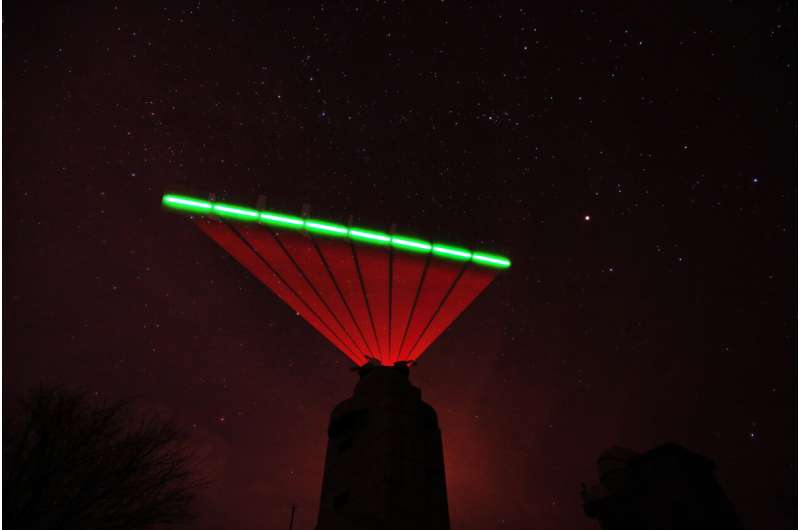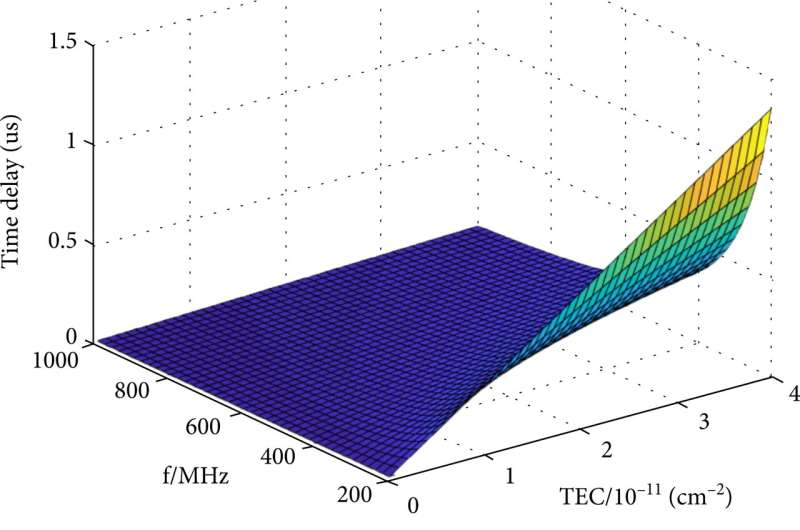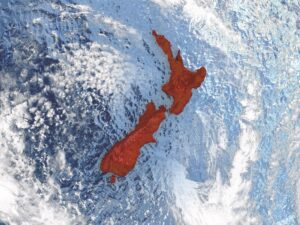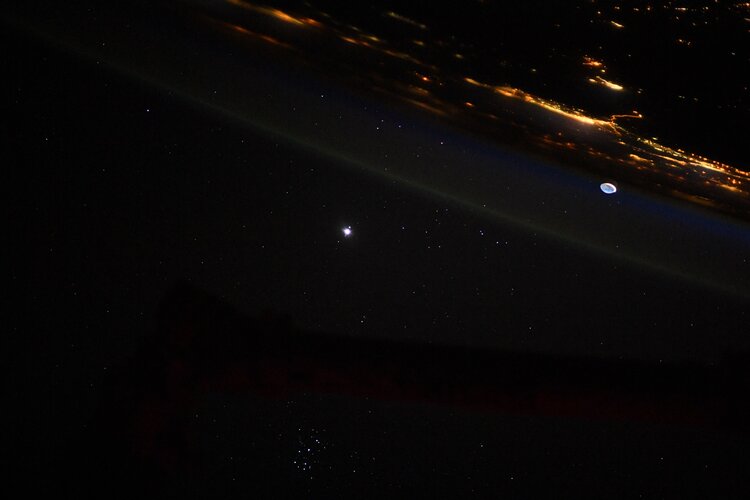Compact QKD system paves the way to cost-effective satellite-based quantum networks
Thursday, 18 August 2022 16:34
Researchers report an experimental demonstration of a space-to-ground quantum key distribution (QKD) network using a compact QKD terminal aboard the Chinese Space Lab Tiangong-2 and four ground stations. The new QKD system is less than half the weight of the system the researchers developed for the Micius satellite, which was used to perform the world's first quantum-encrypted virtual teleconference.
The demonstration represents an important step toward practical QKD based on constellations of small satellites, a setup considered one of the most promising routes to creating a global quantum communication network.
The effect of Martian ionospheric dispersion on SAR imaging
Thursday, 18 August 2022 16:33
The subsurface of Mars records important historical information on the formation and evolution of the planet. As an ionized medium, the Martian ionosphere plays a special role in radio wave propagation and is directly related to the local communication on Mars and the communication between Mars and Earth.
Therefore, the information on the subsurface and the Martian ionosphere provides a scientific basis for understanding and exploring Mars, as well as for studying the history of geological evolution.
Introducing Huginn
Thursday, 18 August 2022 16:00
ESA astronaut Andreas Mogensen of Denmark is set to return to the International Space Station for his first long-duration Station mission. With only one year left before his launch in mid-2023, a name for the mission has been chosen: Huginn.
Op-ed | Taking the Number 8 Wire Mindset to Space: New Zealand’s Approach to the Space Economy
Thursday, 18 August 2022 13:27
No other country does space quite like New Zealand.
The post Op-ed | Taking the Number 8 Wire Mindset to Space: New Zealand’s Approach to the Space Economy appeared first on SpaceNews.
Art for Artemis exhibition opening soon
Thursday, 18 August 2022 12:05
See all 22 artworks submitted for the Art for Artemis project on display at the Waterfront in Bremen, Germany. The formal opening of the exhibition is on 22 August at 17:00 CEST with ESA astronaut Thomas Reiter and will be open to the public throughout the Artemis I mission to the Moon and back.
Voyager, NASA's longest-lived mission, logs 45 years in space
Thursday, 18 August 2022 12:04
NASA's twin Voyager probes have become, in some ways, time capsules of their era: They each carry an eight-track tape player for recording data, they have about 3 million times less memory than modern cellphones, and they transmit data about 38,000 times slower than a 5G internet connection.
Yet the Voyagers remain on the cutting edge of space exploration. Managed and operated by NASA's Jet Propulsion Laboratory in Southern California, they are the only probes to ever explore interstellar space—the galactic ocean that our sun and its planets travel through.
The sun and the planets reside in the heliosphere, a protective bubble created by the sun's magnetic field and the outward flow of solar wind (charged particles from the sun).
Mynaric hires president to oversee production of laser communications systems
Thursday, 18 August 2022 10:40
Mynaric has hired an experienced executive from the optical communications and semiconductor industries as its new president, charged with overseeing production of its laser communications systems.
The post Mynaric hires president to oversee production of laser communications systems appeared first on SpaceNews.
Heatwaves and climate change
Thursday, 18 August 2022 08:00 Video:
00:02:50
Video:
00:02:50
The series of heatwaves we are currently experiencing in western Europe is a clear sign of human-induced global warming. ESA’s Clement Albergel explains how we monitor these events using satellites such as the Copernicus Sentinel-3 mission and puts them in the context of the long-term climate data record generated via ESA’s Climate Change Initiative.
R3-IoT becomes Krucial to branch out of aquaculture
Thursday, 18 August 2022 07:00
Scottish startup R3-IoT rebranded as Krucial Aug. 18 amid plans to expand its connectivity solutions for remote sensors out of the aquaculture market.
The post R3-IoT becomes Krucial to branch out of aquaculture appeared first on SpaceNews.
NASA's new rocket on launchpad for trip to Moon
Thursday, 18 August 2022 03:40 NASA's giant new SLS rocket arrived at its launchpad Wednesday in Cape Canaveral ahead of a planned flight to the Moon in less than two weeks.
It will be the maiden voyage of the Artemis program - America's quest to return humans to the Moon for the first time since the last Apollo mission in 1972.
The Artemis 1 mission, an uncrewed test flight, will feature the first blastoff of the Sp
NASA's giant new SLS rocket arrived at its launchpad Wednesday in Cape Canaveral ahead of a planned flight to the Moon in less than two weeks.
It will be the maiden voyage of the Artemis program - America's quest to return humans to the Moon for the first time since the last Apollo mission in 1972.
The Artemis 1 mission, an uncrewed test flight, will feature the first blastoff of the Sp Voyager logs 45 years in space as NASA's longest mission to date
Thursday, 18 August 2022 03:40 Launched in 1977, the twin Voyager probes are NASA's longest-operating mission and the only spacecraft ever to explore interstellar space.
NASA's twin Voyager probes have become, in some ways, time capsules of their era: They each carry an eight-track tape player for recording data, they have about 3 million times less memory than modern cellphones, and they transmit data about 38,000 time
Launched in 1977, the twin Voyager probes are NASA's longest-operating mission and the only spacecraft ever to explore interstellar space.
NASA's twin Voyager probes have become, in some ways, time capsules of their era: They each carry an eight-track tape player for recording data, they have about 3 million times less memory than modern cellphones, and they transmit data about 38,000 time Russian spacewalk cut short due to issue with suit
Thursday, 18 August 2022 03:40 A spacewalk by two Russians on Wednesday was ended abruptly due to a problem with the battery in cosmonaut Oleg Artemyev's suit, though at no point was he in any danger, the US and Russian space agencies said.
"Oleg, you must return to the airlock as soon as possible," the Earth-based Russian mission controllers ordered, more than two hours into his trip outside the International Space Stat
A spacewalk by two Russians on Wednesday was ended abruptly due to a problem with the battery in cosmonaut Oleg Artemyev's suit, though at no point was he in any danger, the US and Russian space agencies said.
"Oleg, you must return to the airlock as soon as possible," the Earth-based Russian mission controllers ordered, more than two hours into his trip outside the International Space Stat Rocket Lab to launch 150th satellite with upcoming Synspective SAR launch
Thursday, 18 August 2022 03:40 Rocket Lab USA, Inc (Nasdaq: RKLB) has announced its upcoming 30th Electron launch will deliver its 150th payload and 300th Rutherford engine to space. The mission is a dedicated launch for Japanese Earth-imaging satellite constellation operator Synspective.
"The Owl Spreads Its Wings" mission is scheduled to lift-off from Pad B at Rocket Lab Launch Complex 1 in New Zealand during a launch
Rocket Lab USA, Inc (Nasdaq: RKLB) has announced its upcoming 30th Electron launch will deliver its 150th payload and 300th Rutherford engine to space. The mission is a dedicated launch for Japanese Earth-imaging satellite constellation operator Synspective.
"The Owl Spreads Its Wings" mission is scheduled to lift-off from Pad B at Rocket Lab Launch Complex 1 in New Zealand during a launch Virgin Orbit earns AS9100 Certification
Thursday, 18 August 2022 03:40 The Performance Review Institute (PRI) Registrar recently certified Virgin Orbit (Nasdaq: VORB) as having met stringent international standards. This achievement promotes Virgin Orbit's ongoing commitment to satisfying stakeholders, and the Company's dedication to continual improvement of its quality management system.
The globally recognized AS9100 standard builds upon the ISO 9000 family
The Performance Review Institute (PRI) Registrar recently certified Virgin Orbit (Nasdaq: VORB) as having met stringent international standards. This achievement promotes Virgin Orbit's ongoing commitment to satisfying stakeholders, and the Company's dedication to continual improvement of its quality management system.
The globally recognized AS9100 standard builds upon the ISO 9000 family 
 Image:
A special Moon snap
Image:
A special Moon snap